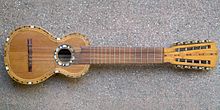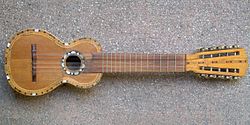Charango


- This article is about an instrument. For the album by British Trip-Hop band Morcheeba, see Charango. For the Cuban style of music, see "charanga".
The charango is a small South American stringed instrument of the lute family, about 66 cm long, traditionally made with the shell of the back of an armadillo. It typically has 10 strings in five courses of 2 strings each, although other variations exist.
History
When the Spanish conquistadores came to Bolivia, they brought the vihuela (an ancestor of the classical guitar) with them. It is not clear from which Spanish stringed instrument the charango is a direct descendant. It may have evolved from the vihuela, bandurria (mandolin), or the lute. There are many stories of how the charango came to be made with its distinctive diminutive soundbox of armadillo. One story says that the native musicians liked the sound the vihuela made, but lacked the technology to shape the wood in that manner. Another story says that the Spaniards prohibited natives from practicing their ancestral music, and that the charango was a (successful) attempt to make a lute that could be easily hidden under a garment such as a poncho. [citation needed]
The first historic information on the charango was gathered by Vega going back to 1814, when a cleric from Tupiza documented that "the Indians used with much enthusiasm the guitarrillos mui fuis... around here in the Andes of Bolivia they called them Charangos". Turino mentions that he found carved sirens representing playing charangos in some Colonial churches in the highlands of the Altiplano Boliviano. [citation needed]
File #857 of The New Chronicle of Guaman Poma eloquently expresses under the suggestive title "Indian Criollos" a drawing and text representing the Indigenes of Bolivia playing a similar instrument. Assuming the chroniclist is not representing the actual "charango" it is very important to notice that the image he presented is dated in the early 17th century, registering the musical mestizaje of the chord instruments in Bolivia.
It is believed the charango came to be what it is today in the early part of the 18th century in the Andes somewhere in modern-day Bolivia probably from Amerindian contact with Spanish settlers.
The 2005 documentary film "El Charango" (director, Jim Virga; editor, Tula Goenka; assoc producer and sound, Andrew Reissiger) sheds light on the relationship between the charango and Cerro Rico, site of the world's largest silver deposit and therefore the most likely location of the charango's birthplace. El Charango the film
Construction

Traditionally made with a dried armadillo shell for the back and wood for the soundbox top, neck etc, today charangos are commonly made of wood, with a bowled back imitating the shape of the armadillo shell. Unlike most wooden lutes, the body and neck are typically made of a single block of wood, carved into shape. The charango's ten strings require quite a large headstock, often approaching or even exceeding the size of its diminutive sound box. Aside from these visual distinctions, it resembles a small ukulele.
The overall length of a typical charango is about 66 cm, with a string scale length of about 37 cm. However, the number of frets ranges from five to eighteen.
There are many variations in the shape of the top in "plan view" and species of wood, though cedar or spruce family woods are preferred for the soundboard (top), and there is generally a narrowed "waist" somewhat reminiscent of the guitar-family--not the pear-shape of the lute.
The typical construction is a one-piece body and neck, classical guitar style peghead and machine tuners, spruce top, and some degree of ornamentation. Variations include a separate glued-on neck, palisander or ebony vertical tuning pegs, guitar-style box construction, or even a hollowed-out neck. The size and shape of the soundholes is highly variable and may be dual crescents, round hole, oval hole, or even multiple holes of varying arrangement.
More recently solidbody electric and hollowbody acoustic-electric charangos are coming on the scene. The solidbodies are built very much as miniature electric guitars, whereas the acoustic-electrics are usually more like a standard acoustic charango.
The instrument has four to fifteen metal, gut, or nylon strings.
Tuning
The charango has five pairs (or courses) of strings, typically tuned GCEAE. This tuning, disregarding octaves, is similar to the typical C-tuning of the 'ukulele or the Venezuelan cuatro, with the addition of a second E-course. Unlike most other stringed instruments, all ten strings are tuned inside one octave. The five courses are pitched as follows (from 5th to 1st course): gg cc eE (because the thicker one is tuned an octave lower) aa ee. Some charanguistas use "octave" strings on other pairs in addition to the middle course. Note that the lowest pitch is the 1st "E" string in the middle course, followed by the "g" course, then the "a" course, then the "c" and finally the "e" strings. This tuning pattern is known as a re-entrant pattern because the pitches of the strings do not rise steadily from one string or course to the next.
The ramifications of the charango tuning is that there is a very narrow tonal range in most chords, and so there is a tremendous wall of sound. Seventh and ninth chords shimmer more than on a guitar due to the close harmonies. More importantly though, in terms of melody playing, the instrumentalist can create a harp-like sound with close intervals ringing out (i.e., like a piano with the sustain pedal engaged). With intervals like minor 2nds and major 2nds fingered on different strings, the charango player can play sustained melodies at rapid speed with an alternating thumb/finger pattern.

Tunings for the charango vary, but the "standardized" ones most commonly used (for the five-stringed version) are:
| Course | Am7 tuning | Comments |
|---|---|---|
| 5 | GG (392 Hz, above middle C) | Lowest tone, highest position |
| 4 | cc (523.25 Hz) | |
| 3 | Ee (329.63 Hz, 659.26 Hz) | Strings are tuned an octave apart |
| 2 | AA (440 Hz) | |
| 1 | ee (659.26 Hz) | Highest tone, lowest position |
Abm7 and Gm7 are achieved by tuning a step or two down, respectively. Em7 is achieved by stepping the appropriate amount down.[citation needed]
Variants
- The walaycho (also hualaycho, or maulincho) is a smaller relative, usually tuned a fourth higher (sometimes a fifth higher) than the charango
- The charangón is a larger relative:
- Some are a 4th down, others a 5th, yet others are an octave down[citation needed]
- Bolivia: tuned in between a ronroco and a charango
- Argentina: one octave below the walaycho (maulincho); presumably a fifth down
- The ronroco is a larger relative of the charango
- Usually tuned one octave lower.[citation needed]
- Bolivia: tuned one octave lower than the charango
- Argentina: tuned a fourth lower than the charango
- The chillador: tuned the same, but with a flat back; usually steel-strung
The number of strings may vary, and includes:
- 4-string
- 5 courses of 3 strings
There are both steel string and nylon string charangos. Some steel-stringed versions have all ten strings at the same gauge. There are also solid-body electric charangos.
Names
The charango is known through different names in the Andes. A few include:
- Mulita and Tatu (in Argentina) and
- Kirkinchu (sometimes "Quirquinchu") and Kirki (in Bolivia and Peru)
There are, of course, various dialects to this slang.
Charango in pop culture
The Gipsy Kings's CD Pasajero (2006) features a Peruvian Charango in a few songs -- most notably Café.
Andrew Reissiger of the world music group Dromedary features the charango on many songs. Reissiger has introduced the instrument to both the Americana/Folk tradition via Jonathan Byrd's The Sea and The Sky and recently on a Puerto Rican CD with Roy Brown, Tito Auger, and Tao Rodriguez-Seeger called "Que Vaya Bien."
Further reading
- Richards, Tobe A. (2006). The Charango Chord Bible: GCEAE Standard Tuning 1,728 Chords. United Kingdom: Cabot Books. ISBN 0-9553944-1-4. — A comprehensive chord dictionary instructional guide.
External links
- Asociación Internacional del Charango AIC (spanish)
- Charango para Todos, el portal de Héctor Soto (spanish)
- Dromedary - American World Music group that features the charango
- Charango Libre (spanish)
- comunidad.ciudad.com.ar (spanish)
- ancient-future.com/guitar/charango
- Familia de los charangos (spanish)
- Charango Bolivia (spanish)
- Musician website of the duo piarango
- charango.org
- Streaming audio of independent charango music by various artists.

